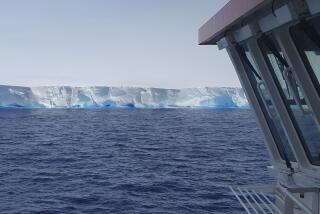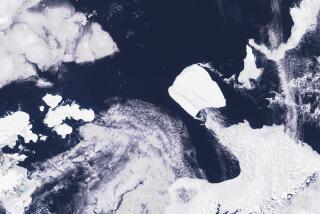Alaskan Swells Broke Antarctic Ice
- Share via
WASHINGTON — A bad storm in Alaska last October generated an ocean swell that broke apart a giant iceberg near Antarctica six days later, U.S. researchers reported Monday.
The waves traveled about 8,300 miles to destroy the iceberg, said Douglas MacAyeal of the University of Chicago and Emile Okal at Northwestern University. Writing in the journal Geophysical Research Letters, they said their study shows how weather in one region can affect conditions far away.
“One of the things we’re debating in the world right now is whether global warming might increase the storminess in the oceans,” MacAyeal said. “The question we then pose is: Could global storminess have an influence on the Antarctic ice sheet that had never been thought of?”
The researchers were watching icebergs using satellites, and saw that on a clear, calm day last October, a big iceberg known as B15A broke into half a dozen pieces. The scientists had put seismometers and other instruments on the 60-mile-long iceberg and on Antarctica’s Ross Ice Shelf.
“We are trying to figure out how the icebergs are sort of making music when various phenomena that we think are linked to the cracking of iceberg masses takes place,” Okal said.
So when they saw B15A break up, they persuaded other researchers in Antarctica to fly over to the berg and retrieve their instruments. The seismometer recorded that although it was mild and clear, the iceberg had been moving up and down and from side to side.
“I was surprised at the level of amplitude that we were recording,” Okal said. The researchers figured a storm somewhere may have generated waves.
“Our jaws dropped,” MacAyeal said. “We looked in the Pacific Ocean and there, 13,500 kilometers away, six days earlier, was the winter season’s first really big, nasty storm that developed and lasted for about a day and a half in the Gulf of Alaska.”
“We saw that the waves in Alaska were about 35 feet tall and then two days later they were down to 15 feet as they passed Hawaii on their way south,” MacAyeal said.
“We think that B15A was in the right position where these waves would be fatal to it,” MacAyeal said. “The iceberg shattered like a gracile wine glass being sung to by a heavy soprano.”
More to Read
Sign up for Essential California
The most important California stories and recommendations in your inbox every morning.
You may occasionally receive promotional content from the Los Angeles Times.










